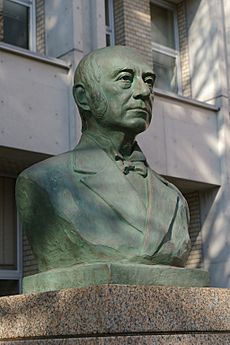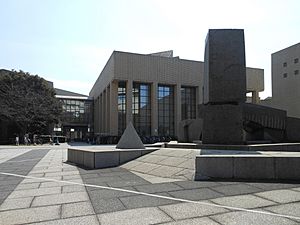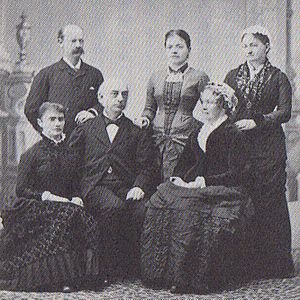James Curtis Hepburn facts for kids
Quick facts for kids
James Curtis Hepburn
|
|
|---|---|
 |
|
| Born | March 13, 1815 Milton, Pennsylvania, U.S.
|
| Died | September 21, 1911 (aged 96) East Orange, New Jersey, U.S.
|
| Nationality | American |
| Known for | Medical missions in China and Japan Hepburn romanization system |
James Curtis Hepburn (born March 13, 1815 – died September 21, 1911) was an American doctor, teacher, and translator. He was also a Christian missionary. He is famous for creating the Hepburn romanization system. This system helps write the Japanese language using the Latin alphabet (like the English alphabet). He made this system popular in his Japanese–English dictionary.
Contents
Early Life and Education
James Curtis Hepburn was born in Milton, Pennsylvania, on March 13, 1815. He went to Princeton University and earned a master's degree. Later, he studied at the University of Pennsylvania. In 1836, he received his degree to become a doctor.
Hepburn decided he wanted to be a medical missionary in China. A medical missionary is someone who travels to help people with their health and share their religious beliefs. He stayed in Singapore for two years before returning to the United States in 1845. Back home, he opened his own medical office in New York City.
Missionary Work in Japan
In 1859, Hepburn went to Japan as a medical missionary. He worked with the American Presbyterian Mission. He first arrived in Nagasaki in October 1859. Soon after, he moved to Yokohama, a port city that had just opened for trade.
In April 1861, he opened his first medical clinic at Sokoji Temple. Hepburn and his family were the first Christian missionaries to live near the new port. They lived in a temple called Jobutsuji in Kanagawa. Hepburn quickly became part of the foreign community there. He even became the honorary doctor for the US Consul, Townsend Harris.
Moving to Yokohama
Hepburn's first clinic did not do well. The Japanese government at the time, called the Bakumatsu authorities, wanted missionaries to move to Yokohama. They put pressure on patients to stop visiting his clinic.
In the spring of 1862, Hepburn and his family moved. They went to a house in the main foreign living area of Yokohama. There, he opened a new clinic. He and his wife, Clara, also started the Hepburn School. This school later grew into Meiji Gakuin University, a well-known university in Japan. Some of Hepburn's Japanese students included important figures like Takahashi Korekiyo.
To honor his medical help in Yokohama, a building was named after him. It is called Hepburn Hall at Yokohama City University School of Medicine.
Creating the Japanese-English Dictionary
In May 1867, Hepburn published a Japanese–English dictionary. He worked with his assistant, Kishida Ginkō, on this project. The dictionary quickly became the main book for anyone wanting to learn Japanese.
In 1886, a new edition of the dictionary came out. For this edition, Hepburn used a new system for writing Japanese words using the Latin alphabet. This system was developed by a group called the Society for the Romanization of the Japanese Alphabet. Because Hepburn's dictionary made this system very popular, it is now widely known as the Hepburn romanization. Hepburn also helped translate the Bible into Japanese.
Later Years and Legacy
James Hepburn returned to the United States in 1892. On March 14, 1905, just after his 90th birthday, he received a special award. It was called the Order of the Rising Sun, third class. This was a very high honor from Japan, and Hepburn was only the second foreigner to receive it.
He passed away on September 21, 1911, in East Orange, New Jersey. He was 96 years old. He is buried in Rosedale Cemetery in Orange, New Jersey.
See also
 In Spanish: James Curtis Hepburn para niños
In Spanish: James Curtis Hepburn para niños
- List of Westerners who visited Japan before 1868
- Sakoku




